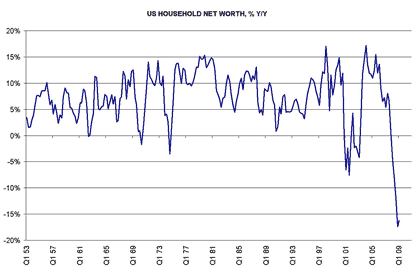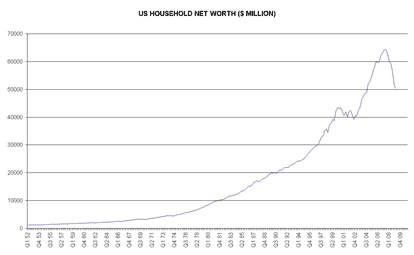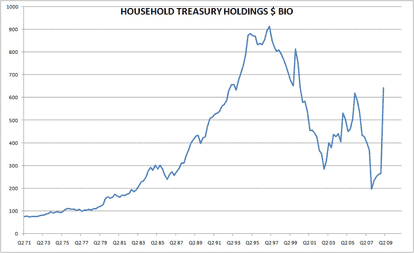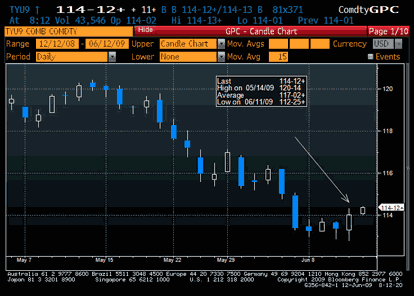Another day, another Chinese data dump. Today’s figures were perhaps more of an unalloyed positive, with retail sales coming in slightly better-than-expected, while industrial production confirmed recent leaks by comfortably exceeding consensus forecasts. Today’s data also left little doubt as to the source of this economic “miracle”, meanwhile; M2 growth printed a robust 25.7% y/y. This left Macro Man wondering….given the sturm und drang of FX reserve managers over American policy choices recently, what would they say if the US pursued an expansion of the money supply as aggressively as China?
Elsewhere, yesterday saw the release of one of Macro Man’s favorite data points, the quarterly Fed flow of funds report. The ebb and flow of household wealth has been a valuable tool in mapping the sometimes bewildering behavior of the US consumer over the years.
The good news from the report, at least if you are a member of the Church of the Second Derivative, is that the pace of decline in household wealth and home equity slowed in Q1. Net wealth fell by “only” $1.3 trillion last quarter, while home equity declined by $450 billion. That compares favorably with losses of $4.8 trillion and $673 billion, respectively, in Q4 of last year. Hey, even the y/y chart has started turning up….good news, right?
Maybe, but when looked at in absolute dollar terms the chart is less encouraging. The wealth destruction in the household sector is breathtaking and provides an obvious explanation as to why savings have increased (and, in Macro Man’s view, will continue to do so.)
Of course, net wealth may well stabilize in the current quarter courtesy of the stock market rally. Of course, what Mr. Market giveth, he can also taketh away. Meanwhile, another interesting note in the flow of funds report was a continued rise in the household debt-servicing burden as a percentage of net wealth ahs reached all time highs.
So it was interesting to observe that the US household sector did a little asset-liability matching in Q1, dramatically increasing its direct holdings of Treasury securities by nearly $400 billion.
There are a couple of notable things about this. The first is that households’ nominal Treasury holdings remain comfortably below their all-time highs notched in the mid-90’s, suggesting that there is ample room for households to buy more. The second is that the Q1 quarterly rise in household Treasury holdings was nearly as large as the top three quarterly rises in Fed custody holdings for central banks combined.
This has led Macro Man to wonder….what if the household sector financed the budget deficit by taking down the issuance? The market seems to subscribe to the view that foreign central banks are the only entity that could possible take the other side of the Treasury’s all-too-frequent auction calendar, but this seems misplaced. A steady rise in savings and a rebalance of household asset towards fixed income could easily take down the Treasury’s entire auction calendar.
In that vein, it was interesting to see that the much-feared 30 year auction came off without a hitch yesterday, delivering a solid bid-to-cover and nary a whisker of a tail. In the follow-through, bonds put in an impressive bounce, forming a key day reversal pattern on the charts in the process….a rather bullish development.
Macro Man has stayed out of the melee in Treasuries over the past few weeks, but yesterday’s developments have him wondering if we might not be on the cusp of a healthy bounce. It might be a trifle dangerous to play a week and a half ahead of the next FOMC meeting, but on his charts we could easily see a 2-3 point bounce in the 10y note future from here.
- Bulenox: Get 45% to 91% OFF ... Use Discount Code: UNO
- Risk Our Money Not Yours | Get 50% to 90% OFF ... Use Discount Code: MMBVBKSM
Disclaimer: This page contains affiliate links. If you choose to make a purchase after clicking a link, we may receive a commission at no additional cost to you. Thank you for your support!







Leave a Reply